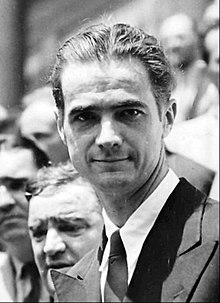Howard Hughes | |
|---|---|
 Hughes in 1938 | |
| Born | Howard Robard Hughes Jr. December 24, 1905 Houston, Texas, U.S. |
| Died | April 5, 1976 (aged 70) Houston, Texas, U.S. |
| Resting place | Glenwood Cemetery |
| Alma mater | California Institute of Technology Rice University (dropped out in 1924)[1] |
| Occupation(s) | Aerospace engineer, business magnate, film producer, investor, philanthropist, pilot |
| Years active | 1926–1976 |
| Title | Chairman and CEO of Summa Corporation Founder of The Howard Hughes Corporation Founder of the Hughes Aircraft Company Founder and benefactor of the Howard Hughes Medical Institute Owner of Hughes Airwest Airlines |
| Board member of | Hughes Aircraft Company Howard Hughes Medical Institute |
| Spouses | |
| Parent(s) | Howard R. Hughes Sr. (father) Allene Stone Gano (mother) |
| Relatives | John Gano (ancestor) Rupert Hughes (uncle) Wright brothers (distant cousins) |
| Awards | Harmon Trophy (1936, 1938) Collier Trophy (1938) Congressional Gold Medal (1939) Octave Chanute Award (1940) National Aviation Hall of Fame (1973) |
| Aviation career | |
| Famous flights | Hughes H-1 Racer, Transcontinental airspeed record from Los Angeles to Newark NJ (1937), round the world airspeed record (1938) |
| Signature | |
Howard Robard Hughes Jr. (December 24, 1905 – April 5, 1976) was an American aerospace engineer, business magnate, film producer, investor, philanthropist and pilot.[2] He was best known during his lifetime as one of the richest and most influential people in the world. He first became prominent as a film producer, and then as an important figure in the aviation industry. Later in life, he became known for his eccentric behavior and reclusive lifestyle—oddities that were caused in part by his worsening obsessive-compulsive disorder (OCD), chronic pain from a near-fatal plane crash, and increasing deafness.
As a film tycoon, Hughes gained fame in Hollywood beginning in the late 1920s, when he produced big-budget and often controversial films such as The Racket (1928),[3] Hell's Angels (1930),[4] and Scarface (1932). He later acquired the RKO Pictures film studio in 1948, recognized then as one of the Big Five studios of Hollywood's Golden Age, although the production company struggled under his control and ultimately ceased operations in 1957.
Through his interest in aviation and aerospace travel, Hughes formed the Hughes Aircraft Company in 1932, hiring numerous engineers, designers, and defense contractors.[5][6]: 163, 259 He spent the rest of the 1930s and much of the 1940s setting multiple world air speed records and building the Hughes H-1 Racer (1935) and the gigantic H-4 Hercules (the Spruce Goose, 1947), the largest flying boat in history with the longest wingspan of any aircraft from the time it was built until 2019. He acquired and expanded Trans World Airlines and later acquired Air West, renaming it Hughes Airwest. Hughes won the Harmon Trophy on two occasions (1936 and 1938), the Collier Trophy (1938), and the Congressional Gold Medal (1939) all for his achievements in aviation throughout the 1930s. He was inducted into the National Aviation Hall of Fame in 1973 and was included in Flying magazine's 2013 list of the 51 Heroes of Aviation, ranked at No. 25.[7]
During his final years, Hughes extended his financial empire to include several major businesses in Las Vegas, such as real estate, hotels, casinos, and media outlets. Known at the time as one of the most powerful men in the state of Nevada, he is largely credited with transforming Las Vegas into a more refined cosmopolitan city. After years of mental and physical decline, Hughes died of kidney failure in 1976. His legacy is maintained through the Howard Hughes Medical Institute and Howard Hughes Holdings Inc.[8]
- ^ Simkin, John. "Howard Hughes".Archived June 3, 2013, at the Wayback Machine Spartacus Educational. Retrieved: June 9, 2013.
- ^ "Howard R. Hughes". UNLV Howard R. Hughes College of Engineering. July 20, 2011. Retrieved July 18, 2018.
- ^ "The Racket (1928)". Turner Classic Movies. Retrieved August 14, 2017.
- ^ "Hell's Angels". Turner Classic Movies. Retrieved August 14, 2017.
- ^ Cite error: The named reference
Rumermanwas invoked but never defined (see the help page). - ^ Cite error: The named reference
Noahwas invoked but never defined (see the help page). - ^ "51 Heroes of Aviation." Archived July 2, 2017, at the Wayback Machine Flying Magazine. Retrieved: December 27, 2014.
- ^ "Howard Hughes, Our Company, History". Howard Hughes Company Website. Retrieved November 6, 2017.